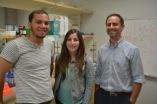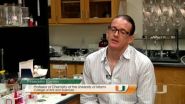(Press-News.org) Green-chemistry researchers at McGill University have discovered a way to use water as a solvent in one of the reactions most widely used to synthesize chemical products and pharmaceuticals.
The findings, published June 26 in Nature Communications, mark a potential milestone in efforts to develop organic reactions in water.
Chao-Jun Li and Feng Zhou of McGill's Department of Chemistry report that they have discovered a catalytic system which for the first time allows direct metal-mediated reactions between aryl halides and carbonyl compounds in water.
For the past two decades, researchers have been exploring ways to do away with chemists' traditional reliance on non-renewable petrochemical feedstocks and toxic solvents. One important method has involved replacing the toxic solvents used in metal-mediated reactions with water – something that was previously considered impossible.
While researchers at McGill and elsewhere have succeeded in using water in metal-mediated reactions between carbonyl compounds and other halides, attempts to do so for the most challenging reaction, between aryl halides and carbonyl compounds, have never worked – until now.
Prof. Li and Dr. Zhou, a postdoctoral fellow, found that rhodium -- a metal primarily used in the catalytic converters of automobiles -- as a catalyst together with zinc as a mediator can make the reaction possible in water. This new technique bypasses a number of challenges posed by conventional practices in carrying out this reaction, which is widely used in synthesizing fine chemicals, biologically active molecules and pharmaceuticals. Traditional methods, discovered more than a century ago, require that moisture and air be carefully excluded from the process.
The new aqueous approach promises to "streamline synthetic sequences and make them safer and more efficient," said Prof. Li, Canada Research Chair in Green Chemistry.
INFORMATION:
The research was supported by the Canada Research Chairs program, the Fonds de recherche du Québec – Nature et technologies, the Natural Sciences and Engineering Research Council of Canada, and the Canada Foundation for Innovation.
"The Barbier-Grignard-Type Carbonyl Arylation Using Unactivated Aryl Halides in Water", Feng Zhou and Chao-Jun Li, Nature Communications, published June 26, 2014. DOI: 10.1038/ncomms5254
A breakthrough for organic reactions in water
Researchers discover way to use water as solvent in a reaction widely used to make chemical products
2014-06-26
ELSE PRESS RELEASES FROM THIS DATE:
Research says TB infection may be underestimated among people taking corticosteroid pills
2014-06-26
TORONTO, June 26, 2014—Tuberculosis infection among people taking corticosteroid pills may be underestimated, new research suggests. Current guidelines for what constitutes a positive TB skin test among corticosteroid pill users may not be capturing all those who are infected, said Dr. Nicholas Vozoris, a respirologist in the Tuberculosis Program at St. Michael's Hospital.
Previous research has shown that people who take corticosteroid pills, such as Prednisone, and have inhaled the TB bacteria, have an eight times higher risk of the bacteria becoming active than people ...
Men and women use mental health services differently
2014-06-26
TORONTO, June 26, 2014 – Women with chronic physical illnesses are more likely to use mental health services than men with similar illnesses; they also seek out mental health services six months earlier than those same men, according to new study from St. Michael's Hospital and the Institute for Clinical Evaluative Sciences (ICES).
"Chronic physical illness can lead to depression," said Dr. Flora Matheson, a scientist in the hospital's Centre for Research on Inner City Health. "We want to better understand who will seek mental health services when diagnosed with a chronic ...
Continued use of low-dose aspirin may lower pancreatic cancer risk
2014-06-26
PHILADELPHIA — The longer a person took low-dose aspirin, the lower his or her risk for developing pancreatic cancer, according to a study published in Cancer Epidemiology, Biomarkers & Prevention, a journal of the American Association for Cancer Research.
"We found that the use of low-dose aspirin was associated with cutting the risk of pancreatic cancer in half, with some evidence that the longer low-dose aspirin was used, the lower the risk," said Harvey A. Risch, MD, PhD, professor of epidemiology in the Department of Chronic Disease Epidemiology at the Yale School ...
Revisions needed for current IV feeding safeguards against bloodstream infections
2014-06-26
Current guidelines to help prevent bloodstream infections during intravenous feeding may need
revisions to strengthen protections for patients, a new study finds.
Researchers at the United Kingdom's University of Southampton found that current guidelines do not account for other independent factors that can affect the growth of potentially deadly microorganisms. Their study was published today in the OnlineFirst version of the Journal of
Parenteral and Enteral Nutrition (JPEN), the research journal of the American Society for Parenteral and Enteral Nutrition (A.S.P.E.N.). ...
Researchers call for patients who receive home nutritional care to have emergency plans
2014-06-26
On the heels of the 2014 hurricane season, researchers are calling for home parenteral and enteral nutrition (HPEN) consumers and their homecare providers to have a comprehensive emergency preparedness plan (EPP) to ensure that special needs are met during the time of a disaster.
In a paper published today in the American Society for Parenteral and Enteral Nutrition's (A.S.P.E.N.) Nutrition in Clinical Practice journal, researchers with Coram Specialty Infusion Services outline the experiences of HPEN consumers and homecare providers in New Jersey affected by Hurricane ...
Researchers discover 'Trojan Horse' method of penetrating cellular walls without harm
2014-06-26
COLLEGE STATION – Scientists with Texas A&M AgriLife Research have found a "Trojan horse" way to deliver proteins into live human cells without damaging them.
The finding, published in this month's Nature Methods, is expected to be easily adopted for use in medical research to find cures and treatments for a wide range of diseases, according to the team's lead scientist, Dr. Jean-Philippe Pellois, an associate professor of biochemistry at Texas A&M University.
"This is something that for many years people have tried to do, because proteins are basic components of the ...
Invasive watersnakes introduced to California may pose risk to native species
2014-06-26
Watersnakes, commonly seen in the lakes, rivers and streams of the eastern United States, are invading California waterways and may pose a threat to native and endangered species in the state, according to a University of California, Davis, study.
While scientists do not know exactly how many watersnakes are in California, roughly 300 individuals of two different species –the common watersnake and the southern watersnake -- have been found in the Sacramento area (Roseville and Folsom), and at least 150 were seen in Long Beach. Researchers suspect the nonvenomous snakes ...
Sequencing efforts miss DNA crucial to bacteria's disease causing power
2014-06-26
Genomic sequencing is supposed to reveal the entire genetic makeup of an organism. For infectious disease specialists, the technology can be used to analyze a disease-causing bacterium to determine how much harm it is capable of causing and whether or not it will be resistant to antibiotics. But new research at Rockefeller University suggests that current sequencing protocols overlook crucial bits of information: isolated pieces of DNA floating outside the bacterial chromosome, the core of a cell's genetic material.
"Extensive sequencing of chromosomal DNA has been performed ...
A win-win-win solution for biofuel, climate, and biodiversity
2014-06-25
Fossil fuel emissions release billions of tons of carbon into the atmosphere each year, which is changing the climate and threatening the sustainability of life on planet Earth. In Brazil, the demand for alternative energy sources has led to an increase in biofuel crops. A new "News and Views" paper in Nature Climate Change, co-authored by Woods Hole Research Center scientists Marcia Macedo and Eric Davidson, reviews new research conducted by Brazilian colleagues demonstrating the high carbon costs of converting intact Brazilian savanna compared to the carbon gains obtained ...
Scientists develop a 'nanosubmarine' that delivers complementary molecules inside cells
2014-06-25
VIDEO:
Francisco Raymo discusses his work in this video.
Click here for more information.
CORAL GABLES, Fla. (June 25, 2014) — With the continuing need for very small devices in therapeutic applications, there is a growing demand for the development of nanoparticles that can transport and deliver drugs to target cells in the human body.
Recently, researchers created nanoparticles that under the right conditions, self-assemble – trapping complementary guest molecules within ...
LAST 30 PRESS RELEASES:
Bacteria resisting viral infection can still sink carbon to ocean floor
Younger biological age may increase depression risk in older women during COVID-19
Bharat Innovates 2026 National Basecamp Showcases India’s Most Promising Deep-Tech Ventures
Here’s what determines whether your income level rises or falls
SCIE indexation achievement: Celebrate with Space: Science & Technology
Children’s Hospital Colorado performs region’s first pediatric heart and liver dual organ transplant
Australian team discover why quantum computers have memory problems over time
What determines the fate of a T cell?
Candida auris: genetic process revealed which could be treatment target for deadly fungal disease
Groundbreaking discovery turns household plastic recycling into anti-cancer medication
Blocking a key inflammatory pathway improves liver structure and vascular function in cirrhosis, study finds
Continuous spread: Raccoon roundworm detected in nine European countries
HKUST Engineering researchers developed a novel photodetector to enhance the performance of on-chip light monitoring
Strategic river sensors could have forewarned of Texas Camp flood disaster
Drone sampling of whale breath reveals first evidence of potentially deadly virus in Arctic
Roman soldiers defending Hadrian’s Wall infected by parasites, study finds
Pinochet’s prisoners were tormented with music but still found solace in it, a new book reveals
Fertility remains high in rural Tanzania despite access to family planning
AI-assisted device can improve autism care access
Kinetic careers
Uncovering how parasitic plants avoid attacking themselves to improve crop resistance
Nanoparticle vaccine strategy could protect against Ebola and other deadly filoviruses
Study finds brain care score can predict risk of stroke across racial groups
Key lung immune cells can intensify allergic reactions
Do hormones explain why women experience more gut pain?
New materials conduct ions in solids as easily as in liquids
Breakthrough of the Year: Renewable energy begins to eclipse fossil fuel-based sources
LLM use is reshaping scientific enterprise by increasing output, reducing quality and more
Introducing LightGen, a chip for ultra-fast, ultra-efficient generative AI
Astronomers see fireworks from violent collisions around nearby star
[Press-News.org] A breakthrough for organic reactions in waterResearchers discover way to use water as solvent in a reaction widely used to make chemical products



